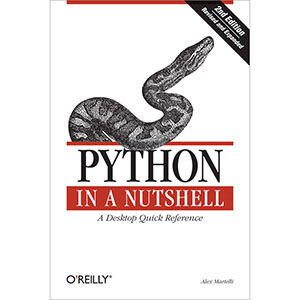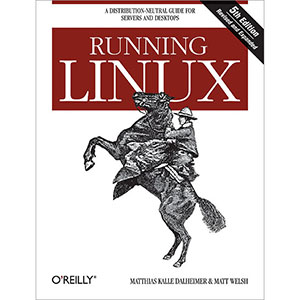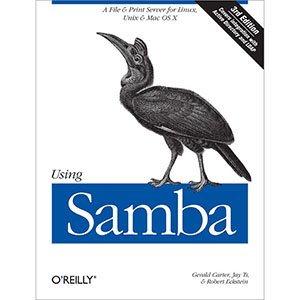Wow! eBook: Python in a Nutshell, 2nd Edition - 5 new eBooks |  |
- Python in a Nutshell, 2nd Edition
- Python Cookbook, 2nd Edition
- Running Linux, 5th Edition
- Using Samba, 3rd Edition
- Postfix: The Definitive Guide
| Python in a Nutshell, 2nd Edition Posted: 26 Sep 2012 05:09 AM PDT
Book DescriptionThis book offers Python programmers one place to look when they needhelp remembering or deciphering the syntax of this open source languageand its many powerful but scantily documented modules. Thiscomprehensive reference guide makes it easy to look up the mostfrequently needed information–not just about the Python languageitself, but also the most frequently used parts of the standard libraryand the most important third-party extensions. Ask any Python aficionado and you’ll hear that Python programmers haveit all: an elegant object-oriented language with readable andmaintainable syntax, that allows for easy integration with componentsin C, C++, Java, or C#, and an enormous collection of precoded standardlibrary and third-party extension modules. Moreover, Python is easy tolearn, yet powerful enough to take on the most ambitious programmingchallenges. But what Python programmers used to lack is a concise andclear reference resource, with the appropriate measure of guidance inhow best to use Python’s great power. Python in aNutshell fills this need. Python in a Nutshell, Second Edition covers morethan the language itself; it also deals with the mostfrequently used parts of the standard library, and the most popular andimportant third party extensions. Revised and expanded forPython 2.5, this book now contains the gory details of Python’s newsubprocess module and breaking news about Microsoft’s newIronPython project. Our “Nutshell” format fits Python perfectly bypresenting the highlights of the most important modules and functionsin its standard library, which cover over 90% of your practicalprogramming needs. This book includes:
Python in a Nutshell provides a solid,no-nonsense quick reference to information that programmers rely on themost. This book will immediately earn its place in any Pythonprogrammer’s library. Praise for the First Edition: “O’Reilly has several good books, of which Python in aNutshell by Alex Martelli is probably the best for giving yousome idea of what Python is about and how to do useful things with it.” Table of Contents Part II: Core Python Language and Built-ins Part III: Python Library and Extension Modules Part IV: Network and Web Programming Part V: Extending and Embedding Book Details
Related Posts
The post Python in a Nutshell, 2nd Edition appeared first on Wow! eBook - Blog. |
| Posted: 26 Sep 2012 05:00 AM PDT
Book DescriptionPortable, powerful, and a breeze to use, Python is the popular open source object-oriented programming language used for both standalone programs and scripting applications. It is now being used by an increasing number of major organizations, including NASA and Google. Updated for Python 2.4, The Python Cookbook, 2nd Edition offers a wealth of useful code for all Python programmers, not just advanced practitioners. Like its predecessor, the new edition provides solutions to problems that Python programmers face everyday. It now includes over 200 recipes that range from simple tasks, such as working with dictionaries and list comprehensions, to complex tasks, such as monitoring a network and building a templating system. This revised version also includes new chapters on topics such as time, money, and metaprogramming. Here’s a list of additional topics covered:
Another advantage of The Python Cookbook, 2nd Edition is its trio of authors–three well-known Python programming experts, who are highly visible on email lists and in newsgroups, and speak often at Python conferences.With scores of practical examples and pertinent background information, The Python Cookbook, 2nd Edition is the one source you need if you’re looking to build efficient, flexible, scalable, and well-integrated systems. Table of Contents Book Details
Related Posts
The post Python Cookbook, 2nd Edition appeared first on Wow! eBook - Blog. |
| Posted: 26 Sep 2012 04:56 AM PDT
Book DescriptionYou may be contemplating your first Linux installation. Or you may have been using Linux for years and need to know more about adding a network printer or setting up an FTP server. Running Linux, now in its fifth edition, is the book you’ll want on hand in either case. Widely recognized in the Linux community as the ultimate getting-started and problem-solving book, it answers the questions and tackles the configuration issues that frequently plague users, but are seldom addressed in other books. This fifth edition of Running Linux is greatly expanded, reflecting the maturity of the operating system and the teeming wealth of software available for it. Hot consumer topics suchas audio and video playback applications, groupware functionality, and spam filtering are covered, along with the basics in configuration and management that always have made the book popular. Running Linux covers basic communications such as mail, web surfing, and instant messaging, but also delves into the subtleties of network configuration–including dial-up, ADSL, and cable modems–in case you need to set up your network manually. The book canmake you proficient on office suites and personal productivity applications–and also tells you what programming tools are available if you’re interested in contributing to these applications. Other new topics in the fifth edition include encrypted email and filesystems, advanced shell techniques, and remote login applications. Classic discussions on booting, package management, kernel recompilation, and X configuration have also been updated. The authors of Running Linux have anticipated problem areas, selected stable and popular solutions, and provided clear instructions to ensure that you’ll have a satisfying experience using Linux. The discussion is direct and complete enough to guide novice users, while still providing the additional information experienced users will need to progress in their mastery of Linux. Whether you’re using Linux on a home workstation or maintaining a network server, Running Linux will provide expert advice just when you need it. Table of Contents Part II: System Administration Part III: Programming Part IV: Network Services Appendix A Sources of Linux Information Book Details
Related Posts
The post Running Linux, 5th Edition appeared first on Wow! eBook - Blog. |
| Posted: 26 Sep 2012 04:51 AM PDT
Book DescriptionThis book is the comprehensive guide to Samba administration, officially adopted by the Samba Team. Wondering how to integrate Samba’s authentication with that of a Windows domain? How to get Samba to serve Microsoft Dfs shares? How to share files on Mac OS X? These and a dozen other issues of interest to system administrators are covered. A whole chapter is dedicated to troubleshooting! The range of this book knows few bounds. Using Samba takes you from basic installation and configuration — on both the client and server side, for a wide range of systems — to subtle details of security, cross-platform compatibility, and resource discovery that make the difference between whether users see the folder they expect or a cryptic error message. The current edition covers such advanced 3.x features as:
Samba is a cross-platform triumph: robust, flexible and fast, it turns a Unix or Linux system into a file and print server for Microsoft Windows network clients. This book will help you make your file and print sharing as powerful and efficient as possible. The authors delve into the internals of the Windows activities and protocols to an unprecedented degree, explaining the strengths and weaknesses of each feature in Windows domains and in Samba itself. Whether you’re playing on your personal computer or an enterprise network, on one note or a full three-octave range, Using Samba will give you an efficient and secure server. Table of Contents Appendix A. Summary of Samba Daemons and Commands Book Details
Related Posts
The post Using Samba, 3rd Edition appeared first on Wow! eBook - Blog. |
| Posted: 26 Sep 2012 04:48 AM PDT
Book DescriptionPostfix is a Mail Transfer Agent (MTA): software that mail servers use to route email. Postfix is highly respected by experts for its secure design and tremendous reliability. And new users like it because it’s so simple to configure. In fact, Postfix has been adopted as the default MTA on Mac OS X. It is also compatible with sendmail, so that existing scripts and programs continue to work seamlesslyafter it is installed. Postfix was written by well-known security expert Wietse Venema, who reviewed this book intensively during its entire development. Author Kyle Dent covers a wide range of Postfix tasks, from virtual hosting to controls for unsolicited commercial email. While basic configuration of Postfix is easy, every site has unique needs that call for a certain amount of study. This book, with careful background explanations and generous examples, eases readers from the basic configuration to the full power of Postfix. It discusses the Postfix interfaces to various tools that round out a fully scalable and highly secure email system. These tools include POP, IMAP, LDAP, MySQL, Simple Authentication and Security Layer (SASL), and Transport Layer Security (TLS, an upgrade of SSL). A reference section for Postfix configuration parameters and an installation guide are included. Topics include:
From compiling and installing Postfix to troubleshooting, Postfix: The Definitive Guide offers system administrators and anyone who deals with Postfix an all-in-one, comprehensive tutorial and reference to this MTA. Table of Contents Appendix A. Configuration Parameters Book Details
Related Posts
The post Postfix: The Definitive Guide appeared first on Wow! eBook - Blog. |
| You are subscribed to email updates from Wow! eBook - Blog To stop receiving these emails, you may unsubscribe now. | Email delivery powered by Google |
| Google Inc., 20 West Kinzie, Chicago IL USA 60610 | |






Tidak ada komentar:
Posting Komentar